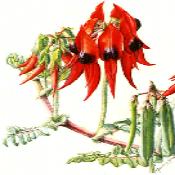
South Australia is classed as the state in south central Australia along the Indian Ocean. It covers an area of 984,377 square kilometres (380,070 square miles). The capital of South Australia is Adelaide and its known as the City of Churches. South Australia became a British colony in 1836 and joined the Commonwealth of Australia in 1901. The state's population is 1,4000,622 and most of those reside in the fertile coastal areas and in the valley of the Murray River which is the only navigable river and drains about one seventh of Australia then enters the sea in South Australia. The first recorded sighting of the South Australian coast was in 1627 when a Dutch ship examined the coastline.
The terrain consists largely of dry wasteland, with several low mountain ranges in which the most important mountains are the Mt Lofty-Flinders Ranges system which extends north about 800 kilometers from Cape Jervis to the northern end of Lake Torrens and salt lakes. Its principal industries and export are wheat, wine and wool. More than half the nations wines are produced here.
South Australia has boundaries with other states on the west, east, north and the south is flanked by the Southern Ocean. South Australia's temperate range is 29C in January and 15C July.
South Australia adopted their flag on 13 January 1904. The flag of South Australia is a British Blue Ensign defaced with the state badge. The badge depicts a white-backed piping shrike (magpie) with wings outstretched on a yellow disc. The state badge is believed to have been designed by Robert Craig of the Adelaide School of Arts.
COAT of ARMS
The State Coat of Arms conferred in a proclamation gazetted on the 19th April, 1984 replaces an earlier Coat of Arms conferred by King Edward VIII in 1936.
For the arms Azure on the rising sun depicted as a roundel Or an Australian Piping Shrike displayed and standing on the staff of a Gum Tree.
Crest - On a wreath Or Azure and Gules Four sprigs of Sturt's Desert Pea.
Shield - Compartment comprising a grassy mount and in front of two vines growing there from each entwining their stakes on either side thereof stalks of wheat and barley and the dexter side scattered with citrus fruits and lying on the sinister side two Cog Wheels with between them a Miner's Pick.
Scroll - The name South Australia
FAUNAL EMBLEM (bird) of the State of South Australia is the PIPING SHRIKE.
The Piping Shrike is the official badge of the South Australian Government and has been for the past 96 years. The Piping Shrike adorns all manner of elements from Government buildings, through to stationery, brochures, flags, banners, sporting attire and promotional clothing, yet very few people seem to know where the design for the Piping Shrike originated, let alone what sort of bird it is.
There has always been discussion on whether it is the common magpie or the Murray magpie and which ever it is, why is it called a Shrike? In almost every backyard was the irrepressible magpie - resourceful, brave and daring in defending its nest and young ones and it had a very sweet song. These qualities were worth representing by way of a heraldic device for the developing State of South Australia.

FLORAL EMBLEM of the State of South Australia is the STURT'S DESERT PEA (Clianthus formosus)
In 1961 the Governemt adopted the Sturt's Desert Pea as the Floral Emblem of South Australia. The plant was formally known as Clianthus dampieri. Sturt's Desert Pea is found over a greater range of South Australia than almost any other plant and is probably the most striking and distinctive of all the plants of Inland Australia. The major portion of this State receives less than 381mm of rain per annum and it is in these regions that Sturt's Desert Pea thrives. The plant is picturesque and most attractive with its soft grey foliage produced on the many prostrate stems often up to 1829mm long. Flowers are produced every foot or so along these stems and the plant in flower is beautifully set off by the attractive grey pinnate foliage.

FAUNAL EMBLEM (animal) is the HAIRY NOSED WOMBAT (Lasiorhinus latifrons)The Hairy Nosed Wobat was adopted by the Government as the faunal emblem of South Australia on 27 August 1970. It is a marsupial mammal indigenous to Australia and totally protected in South Australia.
The Hairy-Nosed Wombat is a thick-set powerful mammal with a broad blunt head, small pointed ears, short muscular legs, strongly clawed feet and a rudimentary tail. It has soft grey-brown silky fur.
Adults are up to 30cm high, 75 to 95cm long, and weigh between 18 and 32 kilos. It is a very powerful digger - only deterred by soft sand and unbroken sheet limestone - and excavates deep cool, humid burrows which are essential for survival in its hot, waterless environment. The wombat feeds exclusively on plant material which often is its only source of water.
A single young measuring only 2cm in length, is born between September and January and remains entirely confined to its mother's backwardly directed pouch for the next five months.

AUSTRALIAN OPALS were adopted by the South Australian Government as the gemstone emblem of South Australia on 15th August 1985. Precious opal ranks with diamond, emerald, ruby and sapphire as one of the most valuable of gemstones. South Australia is the world's most important source of this uniquely beautiful gem.
The State's three major opal fields - Coober Pedy, Mintabie, and Andamooka supply an estimated eighty per cent of total world production. Continued production of high quality precious opal at present levels seems assured while the potential for future discoveries is high.
